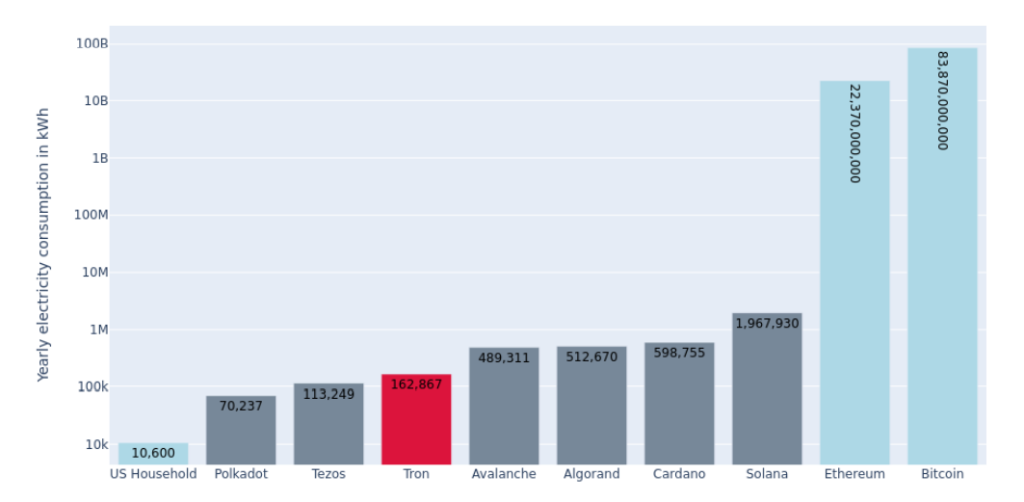
Sponsored
Newby Report by by the “Cryptocarbon Rating Institute (CCRI)” byEnvironmental Sustainability. of theTRON network Energy Efficiency and the Carbon Footprint of the TRON Blockchain” report, the highly popular TRON network consumes the electricity equivalent of only 15 average US homes.
Environmental Sustainability of the TRON Network
The carbon footprint of Bitcoin and other cryptocurrencies in relation to their electricity consumption has been the subject of extensive public, academic and industrial debate. Various estimates exist comparing the electricity consumption of Bitcoin and other cryptocurrencies to various medium-sized countries. This issue has been known for several years and other systems and technologies have emerged that attempt to solve this problem.
Proof of Stake (PoS) consensus mechanisms are considered superior with respect to power requirements compared to traditional Proof of Work (PoW) consensus mechanisms. that PoS does not present the same power problems as PoW. While there is consensus in the broader scientific community, the responsibilities of individual PoS systems are generally not clear.
Due to the nature of the software engineering process and network architecture, different PoS systems will have different hardware requirements, programming languages, network size, transaction throughput, transaction complexity They depend on a variety of fundamentals related to These factors affect power consumption and thus the carbon footprint of the respective networks.
Since an extensive analysis of the power consumption and carbon footprint of the cryptocurrency TRON was not available, this report provides insight into the power consumption, carbon footprint and impact factors of the TRON Proof of Stake blockchain network The purpose of the report is to examine and include.
According to the study, the TRON network can be described as has 367 nodes in , 2.317 billion transactions per year ,Total annual electricity consumption is 162,867.85 kWh , Power per node is 443.78 kWh/year , Power per transaction is 0.07Wh 77} Total carbon emissions are 69.47/year This result assumes a daily number of transactions occurring during the measurement period and extrapolates it to the number of transactions per year required in the context of electricity consumption.
Thus, based on the report’s four-step methodology for obtaining the results, we can conclude that the TRON network is an environmentally sustainable network system. The report outlines an approach for calculating the power consumption and carbon footprint of the TRON network. The research team then selected the appropriate hardware, measured the protocols, and calculated each metric, including key ones such as using the Bitcoin and Ethereum networks for comparison.
As noted above, the research team estimated the annual power consumption of the Proof of Stake network to be 162 867.85 kWh, which is a carbon footprint of 69.47 tons of CO2e annually. Compared to other electricity consumers, such as the average U.S. household, the network consumes only about 15 times as much electricity and produces 11 times as much as an intercontinental round-trip flight.
Overall, the network’s emissions are very low, especially compared to other PoS networks such as Avalanche, Algorand, Cardano and Solana.

TRON’s own delegated proof-of-stake system
Decentralization is built from the ground up: the core vision of TRON is the decentralization of the Internet, and TRON’s strong foundation has led to a successful grassroots process to make TRON operate according to that vision. At a fundamental level, decentralized protocol governance is achieved through the decentralization of consensus. There are several different types of consensus mechanisms in the blockchain, each with its own advantages and disadvantages.
TRON uses delegated proof-of-stake (DPoS) to achieve more decentralization rather than the traditional PoS consensus mechanism Unlike PoS, DPoS allows the community to elect nodes that approve transaction blocks community to elect the node that approves the transaction block. Just as building on a blockchain does not achieve decentralization by default, DPoS does not automatically create a solid foundation for a decentralized system.
In the TRON ecosystem, the community elects 27 block validators every 6 hours as “super representatives” (SRs) for this important task. These SRs are chosen by public vote by the community of users bettingTRX, TRON’s native token, on the blockchain system. 120}regardless of the size of the TRXwager, each SR can only cast one vote, effectively giving them only 3.7% of the vote.
TRON avoids centralized control by eliminating governing power based on staked assets and distributes governing power evenly. As a result, TRON’s adaptation to DPoS created a stronger decentralized foundation than other PoS blockchains.
Like other blockchain networks, TRON’s network is composed of distributed nodes, which form the core of the network infrastructure. An integral part of decentralization, TRON’s nodes are energy efficient. According to the report, the marginal power consumption per transaction for a single node is 0.0007245Ws. The team used carbon footprint regional emission factors to calculate the average carbon intensity of the countries where TRON’s nodes are located. based on the emissions calculated for the TRON network, this DPoS-based blockchain protocol is a very efficient and efficient blockchain protocol that, at its current level, does not even justify discussion of its environmental impact. It consumes an amount of electricity that cannot even be justified, and that it can be concluded that TRON is an environmentally sustainable blockchain network.
To learn more about the TRON network, check out the latest developments at Visit TRON.Network , Telegram , Discord , 155}Reddit , GitHub andTwitter
This is a sponsored post. Learn how to reach your audience here. Please read the following disclaimer.
Image credits: Shutterstock, Pixabay, Wiki Commons {180}














